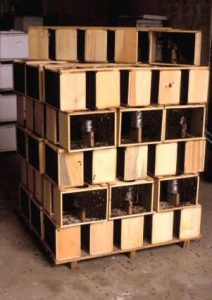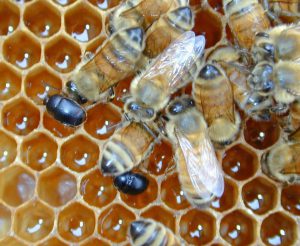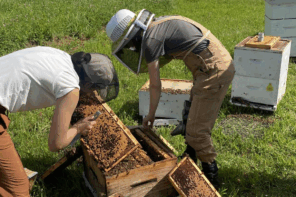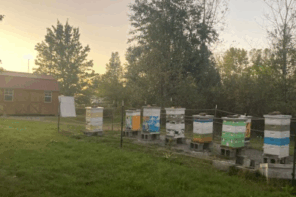 From the Editor, Jerry Hayes
From the Editor, Jerry Hayes
WEED KILLER and BEES
QUESTION
If I spray to kill Johnson Grass on my farm, will I potentially harm my bees? Is there someone that can guide me here? I asked the USDA and they said “use Roundup to kill Johnson grass.” Same advice from all ranch stores in the area. Roundup has glyphosate in it.
Glen
ANSWER
The key here is not to spray or expose colonies to weedkiller directly or indirectly. There are several studies out there that show many times it is not the active ingredient which may negatively impact pollinators but the inactive/inerts like surfactants and adjuvants. These generally do not need regulatory approval so there is a major overlooked issue. The simple universal answer is do not spray pollinator friendly blooming plants that honey bees or any other pollinators are, or will be foraging on and/or directly on colonies or facilitate spray drift to colonies or blooming plants. If they are not exposed then all is well. ‘The dosage makes the poison.’
PACKAGE BEE DIFFERENCES
QUESTION
Started two packages at the same time, fed them the same, they are in the same area, but one is two frames ahead of the other one. No mites or beetles as of right now. There are no other hives within five miles of me. Both are laying and the pattern of the brood is good. Should I replace the queen at this time? Or is this normal? I know (like anything) bees aren’t all the same.
Peter
ANSWER
It could be the queen is laying less for a multitude of reasons (fertilization/heat/cold exposure, chemicals etc., etc.), or that the workers in the original package were older and could not refocus on being ‘nurse’ bees which provide food for their developing sisters or any number of environmental inputs as the foragers were interacting with it.
I would give the queen another few weeks to see how the slower colony evolves in comparison to your other one.
Welcome to beekeeping😊 We love diversity in 2022 and honey bees are it.
OA and GLYCERIN
QUESTION
Wondered what your thoughts are on the “alternate” OA dribble method where you mix warmed food grade glycerin and OA, wet a disposable (blue) shop towel, lay it on top of the frames of the lowest brood super and forget it.
Reportedly, takes the bees three weeks to rip up the towel and throw it out of the hive, so both capped, and uncapped bees get a chance to walk through it.
Reports are it has gone to the EPA for approval.
Barbara
ANSWER
As you have heard me say before, killing a little bug (Varroa) on a big bug (Honey Bee) is a tough job from a collateral pesticide damage perspective and a delivery perspective. To get any Varroa miticide delivered to and into an individual Varroa mite in a directed consistent fashion and have some control effect has been the difficult and inconsistent product development challenge.
For most Varroa control products, the individual Varroa destructor mite has to be in the life stage of an adult exposed (phoretic) in the active honey bee colony itself and not hiding in a worker or drone bee development cell. Varroa has to have the pesticide come in contact with them, enter their body and cause some damage. Damage happens to the honey bees exposed as well but ‘the dose makes the poison,’ so there is harmful chronic collateral damage to the honey bee, as the dose to them is lower, but less acute damage where one sees significant death. That is ALL assuming the user is using a labeled product and following the label directions.
Oxalic acid mixed with glycerin has not been approved as a Varroa control product simply because data indicate that its use is inconsistent, i.e. it doesn’t work all the time. Perhaps in time the delivery of it will be refined and its use be approved and a product labeled. But as of right now it is not and anyone using it will be violating Federal and State Law while gambling with the health of their bees.
STORED FOOD CONSUMPTION
QUESTION
Jerry, I’m already thinking about Winter… sorry. Is it correct when I say that overwintering bees consume less honey in cold weather than milder weather, yes? No fly, less honey consumption, correct?
Ed
ANSWER
Ugh, I don’t want to think about Winter!
When it gets below about 57°F, honey bees start to burn up a lot of calories by movement/shivering, if you will. That is why ‘Winter bees’ are different than Summer bees, having larger fat bodies for stored energy when they are in a cluster and access to stored honey is reduced. They use the stored fat bodies as a ‘fuel’ resource to produce heat and keep the colony and most important the queen alive and healthy.
The largest use of stored honey and why it is stored is brood rearing, which begins early in the new year. That is why bees sometimes starve to death about February/March in the north in particular, because brood rearing picks up, nothing is blooming and honey reserves are depleted. Nurse bees need it to produce liquid food for their sisters and after a few days it is used directly to mix with beebread to feed larvae.
SHB ENTRANCE DEVICE
QUESTION
I have a question about using a specialized entrance to reduce the ability of the hive beetles to access the hive.
I’m curious if you have any experience with these. You mentioned some scientific papers that addressed their use.
Marcus
ANSWER
I am sure it may help reduce SHB entrance into a colony to some degree, but here are some of my thoughts.
SHB are being attracted to a colony because it is emitting stress pheromone odors because it is weakening because of Varroa, AFB, EFB etc,. and population is dropping. SHB is looking for a place for to reproduce. If you do not have a honey bee on every inch of comb, then they cannot protect/police the hive from SHB laying eggs. SHB pick up these stress odors from miles away and locate the colony or the apiary where colonies are mismanaged.
If you look at the many videos on the web, they are using perfect new equipment with no cracks, spaces or misfitting hive parts leaving openings i.e. SHB entrances. Mine are not like that😊
These devices are supposed to be mounted on a standard wooden entrance. If you notice they say because the device is reducing the entrance so much to install an upper entrance so ventilation can happen in hot weather. Another device to buy because the reducers cause other problems.
One of the reasons it may help reduce SHB incursions is because you have cut the entrance width in half or more. Less area for SHB to enter on this perfect new equipment.
I think the best defense against SHB is to have healthy strong colonies because Varroa/Varroa Virus Legacy is controlled, queens are fecund and additional diseases and pests are not an issue. Easier said than done sometimes.
If you want to buy a couple of these and test them out I am sure it would be fun to do. And that is part of hobby beekeeping. If it isn’t fun, don’t do it. But, remember Varroa/Varroa/Varroa… sample, treat if needed, then sample again to see if it worked.











